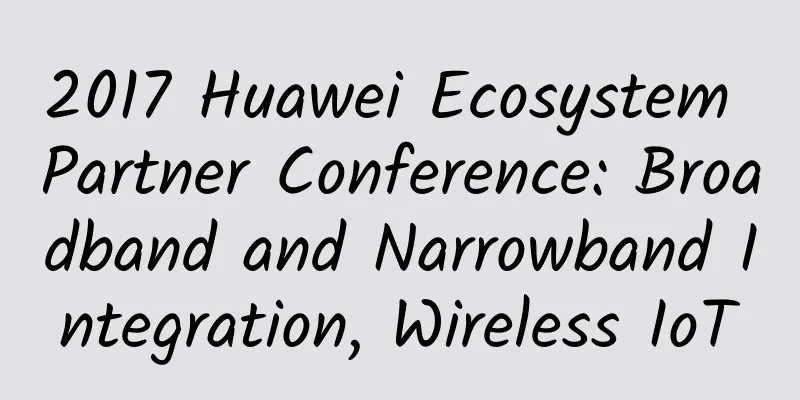Looking ahead to 2017, who will be the top network technology brand?

|
[Original article from 51CTO.com] In 2017, the trend of separating hardware and software will become more obvious. Under the premise that applications are king, people expect to deploy networks with lower costs, stronger performance, and larger capacity, and be able to provide more flexible service models within an expanding scope. In the past year, the reporter has seen the progress of wireless network technology, and also felt the subtle changes in people's deployment and construction of data centers. The layout of 5G has already been in full swing. In 2017, which network technologies will continue to develop impressively? Which dark horse technologies will break through the siege? After interviewing technical directors of many network manufacturers, the reporter compiled and sorted out the most popular network technologies and products in 2017 based on their views, which can help enterprise customers and users to carry out more efficient work.
No. 1: SDN and NFV In 2017, we can expect to see complete commercial software-defined network infrastructure solutions, provided by multiple vendors, based on a viable ecosystem of SDN and NFV components. As users further realize the degree of proprietary platform lock-in, they will feel that closed-door is not appropriate. As enterprises and private data centers begin to see a manageable path to realize the value of flexible infrastructure, adoption will increase significantly, far beyond the scope of early adopters and operators. No. 2: Hyperconvergence Hyper-convergence will undoubtedly continue to be popular in 2017. We have reason to believe that, based on the current storage and computing functions of hyper-convergence, hyper-convergence will also be equipped with a unified management platform and network. You should know that in the hyper-convergence architecture, the amount of data transmitted across nodes is increasing, so the network load is very heavy. The network is also a very important factor that determines the performance of hyper-convergence. No. 3: Unified Wireless Network With the rapid popularization of mobile Internet, user terminal devices often need to roam seamlessly between different network technologies, which will be deployed by extremely diverse network operators. In addition, as network connections change due to capacity, resource connectivity and mobility, devices will begin to use multiple networks at the same time, seamlessly changing data traffic. At the same time, the new generation of wireless networks will begin to adapt to user needs by shifting capacity to where it is needed. In 2017, with the unification of the almost invisible wireless network behind, wireless connections will present an always-connected, high-capacity wireless user experience. No. 4: Mobile Edge Computing (MEC) Technology As networks become more flexible and software-defined, and more types of endpoints connect to them, cloud computing architectures will continue to evolve beyond what we saw in 2016. Of course, applications on mobile devices will continue to work with centralized cloud services. But emerging technologies such as mobile edge computing (MEC) will open up a whole new world of low-power devices that take advantage of local computing resources in the network to save power, or mobile devices that seek self-migrating instances of low-latency network services. In 2017, we will begin to see the rise of this hyper-distributed architecture and its broad impact on future network and application architectures. No. 5: Machine Learning In 2017, we will continue to see machine learning grow in importance as a foundational technology driving innovation across industries. In the context of networking, machine learning techniques will be used to solve problems that were previously thought to be unsolvable. Coupled with SDN and NFV, machine learning will become a core competency for any vendor looking to build next-generation platforms for in-vehicle networks, the Internet of Things (IoT), MEC, cloud, and security. No. 6: 10 Gigabit Ethernet switch Some experts predict that the number of global carrier-grade Ethernet equipment ports will exceed 95 million in 2017, with 10 Gigabit Ethernet growing rapidly and surpassing Gigabit Ethernet. The enterprise market is also optimistic. According to a research report, by 2019, the data center Ethernet switch market is expected to exceed US$11 billion, accounting for 44% of the entire Ethernet switch market. In terms of Ethernet switch ports, many experts expect that 10G ports will continue to grow before 2017, mainly driven by the enterprise market, and will peak in 2018, and then begin to decline. At the same time, 25G/50G and 100G Ethernet switches will see accelerated growth, and it is expected that 25G/50G and 100G ports will account for a quarter of the total Ethernet switch port shipments. No. 7: 5G At MWC2015, China Mobile expected the time node for large-scale deployment of 5G in China to be around 2024. However, this schedule has been brought forward. China's leading 5G promotion agency, the IMT-2020 (5G) Promotion Group, said that my country will launch the second phase of 5G network testing in 2017, conduct large-scale trial networking in 2018, and start 5G network construction in 2019 on this basis, and officially commercialize 5G network as early as 2020. Although China has only entered the 4G era for three years, and the three major operators have only been developing 4G at a high speed for two years, expectations for the accelerated deployment of 5G seem to have already been formed. No. 8: Connected virtual reality (VR) and augmented reality (AR) Virtual reality (VR) and augmented reality (AR) have struggled with technological limitations for decades, but 2016 was clearly the year of breakthrough—consumer VR headsets for video game systems began shipping during the 2016 holiday season, several popular smartphone brands now include VR capabilities, and promising new AR systems are on the verge of release. In 2017, we can expect to see these virtual reality (VR) and augmented reality (AR) systems focused primarily on entertainment and education. But as the platforms become more mature, by mid- to late-2017, we can expect to see experimental applications for communications, data virtualization, and enterprise situational awareness. No. 9: Automation At the infrastructure management level, IT is no longer the dominant force. Business personnel, DevOps, and application development teams jointly decide which technology to choose, how to invest, and how to deploy, so application infrastructure management is a cross-team collaboration. As enterprises begin to embrace DevOps, automation technology will change IT. IT teams will use software to complete a lot of work autonomously instead of relying on manual work, which will allow employees to focus on more strategic tasks. Some experts even predict that AI will take over most of the programming work that developers currently do. No. 10: Network visualization As enterprise networks migrate to the cloud, more and more enterprises are aware of the huge gap between their system environment, network architecture and their visibility needs. In 2017, they will pay more and more attention to network visibility. It is expected that by 2018, 60% of enterprises will reduce security failures by one third through the correct implementation of network visualization. In 2017, we will face new challenges and opportunities. Some technologies can bring us a better user experience, and some technologies can help our network improve performance and enter a new world. I am excited and looking forward to the network industry in 2017. What about you? [51CTO original article, please indicate the original author and source as 51CTO.com when reprinting on partner sites] 【Editor's recommendation】 1. Liu Pingyang of Youpaiyun: The whole industry releases the charm of CDN and the live broadcast market accelerates again 2. If you want to use SDN in 2017 but don’t know these 10 products, you’re out! 3. The troublemakers that kept IT executives up at night in 2017 4. Cisco ASAP helps you subvert traditional architecture by starting the digital transformation of data centers |
<<: Can 20M Wi-Fi be used as 100M broadband? Let me share some knowledge
Recommend
Seven weapons of blockchain technology in the financial field
In the innovation and application exploration of ...
Analyzing the technology behind short videos and reopening the battle against CDN
If the live streaming industry was booming in 201...
When the Internet of Things collides with 5G: What are the biggest conflicts?
Many companies are already using IoT data to hand...
Blockchain technology will change the world in these four ways
As the underlying technology of Bitcoin, blockcha...
Huawei takes four major measures to lay out its computing strategy and launches the new AI training cluster Atlas 900
On September 18, 2019, the fourth HUAWEI CONNECT ...
RAKsmart cloud servers start at 10% off, Hong Kong/Japan/Los Angeles/San Jose cloud servers start at 129 yuan/year
RAKsmart data center has launched the "Every...
ReliableSite: 1Gbps unlimited dedicated server in New York/Miami/Los Angeles starting from $29/month
ReliableSite is a business that specializes in pr...
The most popular network trends in 2019
“SD-WAN has seen incredible market growth since 2...
TmhHost back-to-school season discount: Los Angeles, Japan, South Korea CN2 line VPS quarterly payment starting from 100 yuan
TmhHost's back-to-school season event is stil...
Three things you need to know before embarking on the journey of becoming a data scientist
【51CTO.com Quick Translation】 Currently, the indu...
DiyVM: 69 yuan/month XEN-dual core/2G memory/50G hard disk/5M unlimited traffic/Osaka, Japan data center
DiyVM is a Chinese hosting company founded in 200...
To accelerate 5G innovation and monetization, Ericsson and several operators jointly established a network API company
According to foreign media reports, communication...
Use what-if analysis to meet data center capacity needs
The authors describe the challenges of capacity r...
IPv6 basics, learn in one minute
1. Introduction to IPv6 1. IPv6 was previously kn...
"Goodbye, 2G!" The Ministry of Industry and Information Technology officially announced, netizens: Should we throw away our old phones?
With the development of technology, our generatio...









